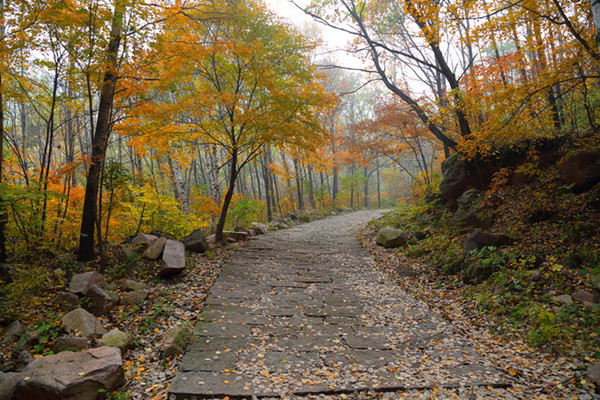 |
|
The mountainous road to Fenghuang Platform. [File photo] |
Explorers can follow an upward path, pause at a pavilion on the hillside, and then climb to the top of Nanhouding. At an altitude of 1,700 meters above sea level, it is the highest mountain in Huairou and the fourth highest in Beijing.
After crossing a forest of tall trees, we arrive at a high mountain steppe. Our vision is suddenly illuminated as we progress towards the ridge, tall grass brushing our calves and breeze caressing our hair. Such pleasant sensations make it a dream for hiking. As we approach the peak, we distinguish a pile of large rocks. Taking a closer look, it seems that this is no scree-fall, but a mysterious piece of work, each rock having been meticulously placed.
After much effort, we finally reach the top and a huge rock of 10 meters across offers a platform to better appreciate the landscape of endless mountains.
The climb to the top of Nanhouding is physically testing but worth the effort for the breathtaking panorama along your route.
The birch forest attracts most tourists to Labagoumen. In Chinese culture, birches are acclaimed in literature. There is also a popular Chinese love song about a birch forest by balladeer Pu Shu. So, a lot of young Chinese associate birch forests with love, youthfulness, and nostalgia. For the older generation, birch forests symbolize the vicissitudes of life, a time when Chinese society was changing.
Autumn is the best season to admire the birches, when their golden leaves stand out against the blue sky, a feast for city-weary eyes. The rough, silver trunks look artistically rustic. With its 4,700 hectares of secondary forest, Labagoumen is the town with the largest forest coverage rate in Beijing. Standing there, listening to the rustling of leaves in the wind and observing the sun’s rays piercing the canopy in places, visitors quickly forget the bustling city and dream of escaping here for a few days.
In October 2010, Li Hao, a graduate student in Beijing, was captivated by the beautiful panorama of Labagoumen. It was the first time Li, a native of Hangzhou (capital of Zhejiang Province), had the chance to appreciate the romantic forests of northern China. The trip left her with a completely different impression from that of the gentle view of the West Lake in her hometown. Today, she continues her doctoral studies in Hong Kong, but keeps her memories of Labagoumen alive. For her, the white birch forest represents a part of her youth in Beijing.
The birch leaves are golden for only one week. Then they fall as the temperature drops and the north wind blows. It’s no wonder that such ephemeral beauty causes people to reflect on life and time.
Each May, Labagoumen's mountains are covered with azaleas in bloom, lasting almost a month. These red flowers reflect a sense of vitality.
In China, azaleas grow mainly in northern China, for example on the Great Khingan, the Changbai Mountains, and Inner Mongolia. They are more rarely found in the Emei Mountains in Sichuan. But they abound in Labagoumen as this town is almost on the same latitude as Inner Mongolia and the altitude is above 1,000 meters. Azalea in Chinese is yingshanhong meaning something “that colors the mountains red.” In Labagoumen, this flower has a light pink hue, which harmoniously blends with the colors of rocks and trees, forming an exceptional landscape.